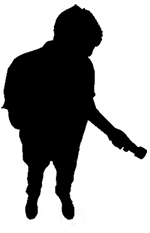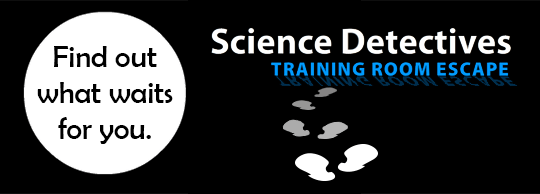
Illustrated by: CJ Kazilek
What is the Scientific Method?
If you have ever seen something going on and wondered why or how it happened, you have started down the road to discovery. If you continue your journey, you are likely to guess at some of your own answers for your question. Even further along the road you might think of ways to find out if your answers are correct. At this point, whether you know it or not, you are following a path that scientists call the scientific method. If you do some experiments to see if your answer is correct and write down what you learn in a report, you have pretty much completed everything a scientist might do in a laboratory or out in the field when doing research. In fact, the scientific method works well for many things that don’t usually seem so scientific.
The Flashlight Mystery...

Like a crime detective, you can use the elements of the scientific method to find the answer to everyday problems. For example you pick up a flashlight and turn it on, but the light does not work. You have observed that the light does not work. You ask the question, Why doesn't it work? With what you already know about flashlights, you might guess (hypothesize) that the batteries are dead. You say to yourself, if I buy new batteries and replace the old ones in the flashlight, the light should work. To test this prediction you replace the old batteries with new ones from the store. You click the switch on. Does the flashlight work? No?

What else could be the answer? You go back and hypothesize that it might be a broken light bulb. Your new prediction is if you replace the broken light bulb the flashlight will work. It’s time to go back to the store and buy a new light bulb. Now you test this new hypothesis and prediction by replacing the bulb in the flashlight. You flip the switch again. The flashlight lights up. Success!
If this were a scientific project, you would also have written down the results of your tests and a conclusion of your experiments. The results of only the light bulb hypothesis stood up to the test, and we had to reject the battery hypothesis. You would also communicate what you learned to others with a published report, article, or scientific paper.
More to the Mystery...
Not all questions can be answered with only two experiments. It can often take a lot more work and tests to find an answer. Even when you find an answer it may not always be the only answer to the question. This is one reason that different scientists will work on the same question and do their own experiments.
In our flashlight example, you might never get the light to turn on. This probably means you haven’t made enough different guesses (hypotheses) to test the problem. Were the new batteries in the right way? Was the switch rusty, or maybe a wire is broken. Think of all the possible guesses you could test.
No matter what the question, you can use the scientific method to guide you towards an answer. Even those questions that do not seem to be scientific can be solved using this process. Like with the flashlight, you might need to repeat several of the elements of the scientific method to find an answer. No matter how complex the diagram, the scientific method will include the following pieces in order to be complete.

- Observation – seeing, hearing, touching…
- Asking a question – why or how?
- Hypothesis – a fancy name for an educated guess about what causes something to happen.
- Prediction – what you think will happen if…
- Testing – this is where you get to experiment and be creative.
- Conclusion – decide how your test results relate to your predictions.
- Communicate – share your results so others can learn from your work.
Other Parts of the Scientific Method…
Now that you have an idea of how the scientific method works there are a few other things to learn so that you will be able test out your new skills and test your hypotheses.
- Control - A group that is similar to other groups but is left alone so that it can be compared to see what happened to the other groups that are tested.
- Data - the numbers and measurements you get from the test in a scientific experiment.
- Variable- Something that can cause something you are testing to change. There are several kinds of variables.
- Independent variable - a variable that you change as part of your experiment. It is important to only change one independent variable for each experiment.
- Dependent variable - a variable that changes when the independent variable is changed.
- Controlled Variable - these are variables that you never change in your experiment.
Practicing Observations and Wondering How and Why...
It is really hard not to notice things around us and wonder about them. This is how the scientific method begins, by observing and wondering why and how. Why do leaves on trees in many parts of the world turn from green to red, orange, or yellow and fall to the ground when winter comes? How does a spider move around their web without getting stuck like its victims? Both of these questions start with observing something and asking questions. The next time you see something and ask yourself, “I wonder why that does that, or how can it do that?” try out your new detective skills, and see what answer you can find.
Try Out Your Detective Skills
Now that you have the basics of the scientific method, why not test your skills? The Science Detectives Training Room will test your problem solving ability. Step inside and see if you can escape the room. While you are there, look around and see what other interesting things might be waiting. We think you find this game a great way to learn the scientific method. In fact, we bet you will discover that you already use the scientific method and didn't even know it.
Click to play
After you've learned the basics of being a detective, practice those skills in The Case of the Mystery Images. While you are there, pay attention to what's around you as you figure out just what is happening in the mystery photos that surround you.
We thank John Alcock for his feedback and suggestions on this article.
Science Detectives - Mystery Room Escape was produced in partnership with the Arizona Science Education Collaborative (ASEC) and funded by ASU Women & Philanthropy.
Flashlight image via Wikimedia Commons - The Oxygen Team
Read more about: Using the Scientific Method to Solve Mysteries
Bibliographic details:
- Article: Using the Scientific Method to Solve Mysteries
- Author(s): CJ Kazilek and David Pearson
- Publisher: Arizona State University School of Life Sciences Ask A Biologist
- Site name: ASU - Ask A Biologist
- Date published:
- Date accessed:
- Link: https://askabiologist.asu.edu/explore/scientific-method
APA Style
CJ Kazilek and David Pearson. (). Using the Scientific Method to Solve Mysteries. ASU - Ask A Biologist. Retrieved from https://askabiologist.asu.edu/explore/scientific-method
Chicago Manual of Style
CJ Kazilek and David Pearson. "Using the Scientific Method to Solve Mysteries". ASU - Ask A Biologist. . https://askabiologist.asu.edu/explore/scientific-method
CJ Kazilek and David Pearson. "Using the Scientific Method to Solve Mysteries". ASU - Ask A Biologist. . ASU - Ask A Biologist, Web. https://askabiologist.asu.edu/explore/scientific-method
MLA 2017 Style

Do you think you can escape our Science Detectives Training Room?
Be Part of
Ask A Biologist
By volunteering, or simply sending us feedback on the site. Scientists, teachers, writers, illustrators, and translators are all important to the program. If you are interested in helping with the website we have a Volunteers page to get the process started.

